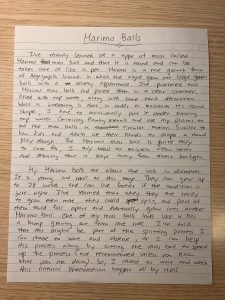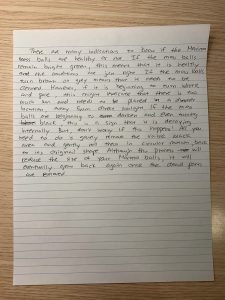Handwritten entry:




I cannot remember how many years it has been since I’ve written this much in a single day. I believe I’ve relied on typing ever since graduating from high school. I have always typed, rather than handwriting, through my undergrad years and various work environments because it was much faster, more convenient, and a required skill. I found this task to be quite challenging because I can’t help but feel a bit ashamed to have such messy printing. I know that I am a hypocrite since I teach grade 1/2s and have always emphasized and encouraged my students to print neatly, and often corrected and commented on their printing. Even more of a hypocrite when I’ve asked my students NOT to cross out misspelt words and have a good habit of using an eraser, whereas I am just crossing out my mistakes here, thus contradicting myself.
A 500 words passage is not a lot when we type it out, but handwriting 500 words passage was more work than I remember. I had to take multiple breaks in between to shake my hand and relax my grip before continuing. I feel that I owe my students an apology as I often ask them to “elaborate more” or “add more details in your writing,” etc. Now I am reminded just how much work it takes to print a full page of writing.
Listening to Harris describe the amount of work it took to hand-drawn customed prints, I can’t imagine the amount of time it took to produce one good quality scribes between year 400 – 1400 (Harris, 2018). The amount of patience and no room for errors compared to my messy scribbles with crossed-out spelling mistakes. My handwriting is no match to the skilful transcribers back in the day as different era requires different skillsets.
Different era requires different mediums to meet the needs of the production at the time. Even with the development of the printed press, it was still timeconsuming labour to produce quality prints. As Innis pointed out that in 1538, France was able to print at the speed of 20-200 leaves per hour. This later progressed to the development of printing 250-1000 copies an hour between 1814-1853 and reaching 12, 000 copies per hour (Innis, 2007). This process is difficult to fathom as nowadays we rely on a button to print, not knowing that printing press came a long way from individual carved letters organized to form a word, to now done digitally.
Even though I admire the beauty and process of printmaking, I still prefer typing on a keyboard. Printmaking and handwriting are both time consuming and allowing minimal room for errors. The only time I will be handwriting is when I need to demonstrate my work on a whiteboard for teaching purposes.
References
Harris, B. (HOST). (2018, February 5). The Printed Book: Opening the Floodgates of Knowledge [Audio podcast episode]. How It Began: A History of The Modern World. Retrieved from https://howitbegan.com/episodes/the-printed-book/
Innis, H. (2007) Empire and Communications. Toronto: Dundurn Press.